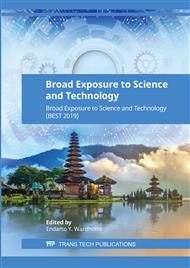p.80
p.87
p.95
p.101
p.108
p.114
p.122
p.128
p.137
Development of Bamboo - Derived Activated Carbon as Catalyst Support for Glucose Hydrogenation
Abstract:
Indonesia possesses high potential to develop an advanced biorefinery system, thanks to its high richness of natural resources. Bamboo for instance, with more than 200 species, in which 5% of its global distribution is found in Indonesian archipelago, is an invaluable resource to develop many useful materials. Here in this study, bamboo has been used to produce activated carbon for catalyst material. Bamboo raw material was obtained from a city park in Surabaya, and converted to activated carbon through carbonization at 773 K, followed by activation using acidic solution. The activated carbon (AC) was used as catalyst support, impregnated by nickel (Ni) as metal active. The catalyst was used in conversion of glucose to glucitols (sorbitol, mannitol) trough reduction with hydrogen. The Ni/AC was applied as catalyst for hydrogenation of glucose, conducted at 0.5 MPa and 363 – 403 K. With surface area of 125 m2/g of the carbon supported catalyst applied, glucose could be converted to polyols with overall yield of approximately 3 wt % from the total products.
Info:
Periodical:
Pages:
108-113
Citation:
Online since:
April 2020
Keywords:
Price:
Сopyright:
© 2020 Trans Tech Publications Ltd. All Rights Reserved
Share:
Citation:


